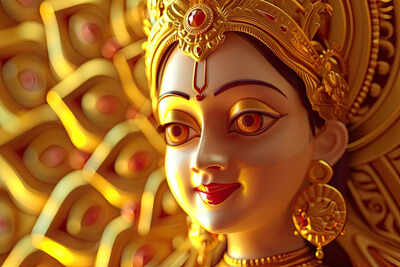ARTICLE AD BOX

Navratri brings joy to countless people around India and the world. Not only is there an astrological meaning to worshipping the nine forms of Goddess Durga (Navadurga), but it also holds a divine meaning as well and has roots in authentic and traditional spirituality.
The nine forms of Durga represent archetypes and mythology of energies that control a person's life, and destiny, as interfaces of the planets.The nine planets all influence how we interact with the entire cosmos. The heavenly bodies influence and determine our karmas, our fortunes, our struggles, and even our spiritual development. The nine forms of Durga interface with the nine forms of Shakti that counteract negativity, and if the soul is uplifted.
It is widely recognized that worshiping the nine forms of Durga during Navratri enables the planetary influences to align with one another and subsequently brings harmony to one's life in a prosperous fashion.Day 1 – ShailputriOn the first day of Navratri, Shailputri is venerated and referred to as "daughter of the mountains." Shailputri embodies stability, purity, and moon power. In astrology, the Moon governs the mind and emotions; thus, Shailputri helps to bring peace, fortitude, and conscious clarity, especially when confused or overwhelmed.
Day 2 – BrahmachariniOn day two, we turn our reverence to Brahmacharini, who signifies austerity, penance, and self-discipline. She has an association with the planet Mars, embodying energy, bravery, and will. A devotee seeks her blessings for focus, will, and their best chance for success academically or in their careers. She is gracious in providing blessings to mitigate impulsiveness or aggression conjoined with Mars energy.Day 3 – ChandraghantaThe third day is dedicated to Goddess Chandraghanta, who embodies grace, beauty, and courage. Goddess Chandraghanta represents the planet Venus, the planet of love, luxury, and relationships. Worshipping Goddess Chandraghanta is said to dispel discord, help unite families, and attract both material and spiritual wealth.Day 4 – KushmandaOn the fourth day of Navratri, the goddess, Kushmanda, created the entire universe with just her smile.
Kushmanda represents vitality, creativity, and the Sun, which represents the soul and energy that creates and sustains life. She is honored for strength and self-confidence, leadership, and health while diminishing the bad effects of a weak Sun in one's astrological chart.Day 5 – SkandamataOn the fifth day, Skandamata is worshipped, who carries Kartikeya (Skanda) on her lap, representing motherhood, compassion, and wisdom.
She is associated with Mercury, the planet of intelligence, communication, and learning. Those who worship Skandamata do so to gain wisdom, clarity in making decisions, and effective communication.Day 6 – KatyayaniOn the sixth day, the warrior goddess Katyayani is revered as courage, justice, and the removal of evil. She is associated with Jupiter, the planet tapping into wisdom, morality, and spirituality.
Worshipping Katyayani helps the person strengthen their morals, gain divine knowledge, and break through challenges in their job.Day 7 – KaalratriOn the seventh day, devotees worship Kaalratri - the "Fierce Goddess" of Durga who eliminates darkness, ignorance, and delusion. She is associated with Saturn (Shani), the planet of discipline, karma, and endurance. Worshipping Kaalratri diminishes the difficulty of Saturn's periods of difficulties, endows the devotee with endurance, and protects against evil spirits and energies.Day 8 – MahagauriThe eighth facet of the Divine Mother is Mahagauri, the aspect of pure, peaceful, and calm energy. She is paired with Rahu, a shadow planet linked to illusions, appetites, and sudden change. In asking for Mahagauri's blessings, you are striving to purify your emotional thinking, to cleanse yourself of materialism and cravings, and to unbind yourself from karmas.Day 9 – SiddhidatriThe last day of Navratri is dedicated to Siddhidatri. This goddess symbolizes the granting of siddhis (spiritual powers) and the bestowal of ultimate perfection.
Siddhidatri is connected with the planet Ketu, which represents detachment and spirituality. As Ketu is linked to higher consciousness, Siddhidatri offers the ignorant wisdom and brings seekers into self-realization.The Divine SynergyThe Navadurga, along with the Navagrahas, presents a powerful spiritual-astrological matrix. Just as the planets have an impact on the destinies of man, the nine forms of Durga are markers for divine energies to heal imbalances, resolve karmic barriers, and augment virtues; when we vow to them during Navratri, we are participating in a Person-Planet Universal alignment and bringing harmony to the body, mind, and soul, similarly to a healing modality.In today's fast-paced world filled with anxiety and uncertainty while chasing material desires, the astrological significance of Navratri worship is truly relevant; a day of devotion aligns an individual with planetary energies that bring a type of balance between worldly and spiritual advances. These two dimensions of astrology and the divine characterize Navratri as more than only a festival of faith, but in and through the divine, a real cosmic opportunity for transformation.Written By: Tarot Pooja Verma, Tarot Card Reader & Numerologist..!!



.png)
.png)
.png)
















 1 hour ago
3
1 hour ago
3









 English (US) ·
English (US) ·